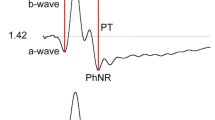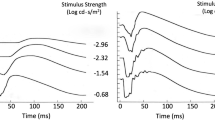Abstract
Utilizing a high intensity photographic flash unit, electroretinograms were recorded from normal adults under fully light adapted conditions over a 5 log unit range of stimulus luminance (-1.35 to 3.34 log cd-s/m2). At lower luminance levels b-wave amplitude increased with increased luminance until it reached a maximum (Vmax of the Naka-Rushton equation) in agreement with previous work. At higher luminance levels, the b-wave amplitude decreased to 33% of Vmax and then plateaued. This previously unreported phenomenon has been named the photopic hill. There was no appreciable change in b-wave amplitude with increased interstimulus intervals from 15 sec to 5 min and luminance-response functions serially recorded for increasing and for decreasing stimulus luminance were very similar. These latter results indicate that the photopic hill is not due to light adaptation. The reason for the photopic hill and possible clinical implications are discussed.
Similar content being viewed by others
Abbreviations
- ISI:
-
interstimulus interval
- L-R function:
-
luminance-response function
- ND:
-
neutral density
References
Peachey NS, Alexander KR, Fishman GA. The luminance-response function of the dark-adapted human electroretinogram. Vision Res 1989; 29: 263–70.
Aylward GW, Jeffrey BG, Billson FA. Normal variation and the effect of age on the parametric analysis of the intensity-response series of the scotopic electroretinogram including the scotopic threshold response. Clin Vision Sci 1990; 5: 353–62.
Wali N, Leguire LE. Fundus pigmentation and the dark-adapted electroretinogram. Doc Ophthalmol 1992; 80: 1–11.
Peachey NS, Alexander KR, Fishman GA, Derlacki DJ. Properties of the human cone system electroretinogram during light adaptation. Appl. Optics 1989; 28: 1145–50.
Wack MA, Peachey NS, Fishman GA. Electroretinographic findings in human oculocutaneous albinism. Ophthalmol 1989; 96: 1778–85.
Naka KI, Rushton WAH. S-potentials from color units in the retina of fish (Cyprinidae). J Physiol 1966; 185: 536–55.
Witkovsky P. Excitation and adaptation in the vertebrate retina. Curr Top Eye Res 1980; 2: 1–66.
Boynton RM, Whitten DN. Visual adaptation in monkey cones: recordings of late receptor potentials. Science 1970; 170: 1423–6.
Normann RA, Werblin FS. Control of retinal sensitivity. I. Light and dark adaptation of vertebrate rods and cones. J Gen Physiol 1974; 63: 37–61.
Schneider T, Olsen BT, Zrenner E. Characteristics of the rod-cone transition in electroretinogram and optic nerve response. Clin Vision Sci 1986; 1: 81–91.
Dowling JE. The retina. An approachable part of the brain. Cambridge, Mass: The Belknap Press of Harvard University Press, 1987: 187–223.
Hood DC, Hock PA. Recovery of cone receptor activity in the frog's isolated retina. Vision Res 1973; 13: 1943–51.
Author information
Authors and Affiliations
Rights and permissions
About this article
Cite this article
Wali, N., Leguire, L.E. The photopic hill: A new phenomenon of the light adapted electroretinogram. Doc Ophthalmol 80, 335–342 (1992). https://doi.org/10.1007/BF00154382
Accepted:
Issue Date:
DOI: https://doi.org/10.1007/BF00154382




